The AMD 2nd Gen Ryzen Deep Dive: The 2700X, 2700, 2600X, and 2600 Tested
by Ian Cutress on April 19, 2018 9:00 AM ESTNew X470 Chipset and Motherboards
A Focus on Power
For our reviews, AMD shipped us two motherboards: the ASUS ROG Crosshair VII Hero (Wi-Fi) and the MSI X470 Gaming M7 AC. These will be two of the high-end halo motherboards to focus on the new X470 chipset.

Katamari loves motherboards. Or just loves sitting on my review samples. (ed: it's the latter)
The new X470 chipset is designed to sit above the X370 chipset, although looking at the specifications, users might be forgiven for not seeing a difference. Technically the X470 part has identical PCIe and SATA support to the older X370 chipset, and for a while AMD will be running both chipsets concurrently for the main motherboard manufacturers to use. Both sets of boards will be using the AM4 chipset, which AMD has guaranteed to support for several generations now.
| AMD AM4 Chipsets AnandTech |
|||||||||||||
| DDR4 | OC | USB | SATA | PCIe 2.0 |
GPU | XFR2 PB2 |
StoreMI | TDP | RAID SATA |
RAID NVMe |
|||
| 3.1 | 3.0 | 2.0 | |||||||||||
| X470 | 2933 | Y | 2 | 6 | 6 | 6 | 8 | x8/x8 | Y | Y | 4.8W | 0,1,10 | |
| X370 | 2667 | Y | 2 | 6 | 6 | 6 | 8 | x8/x8 | N | N | 6.8W | 0,1,10 | |
| B350 | 2667 | Y | 2 | 2 | 6 | 4 | 6 | x16 | N | N | 6.8W | 0,1,10 | |
| A320 | 2667 | N | 1 | 2 | 6 | 4 | 4 | x16 | N | N | 6.8W | 0,1,10 | - |
| Embedded | |||||||||||||
| X300 | 2667 | Y | 0 | 4 | 0 | 2 | 4 | x8/x8 | N | N | ? | 0,1 | - |
| B300 | 2667 | N | 0 | 4 | 0 | 2 | 4 | x16 | N | N | ? | 0,1 | - |
| A300 | 2667 | N | 0 | 4 | 0 | 2 | 4 | x16 | N | N | ? | 0,1 | - |
The big change in the chipset will be in the power consumption. Currently the X370 chipset, built on a 55nm manufacturing process using ASMedia IP, runs at a 6.8W TDP (running at full load). For X470, we were told that this is the same process and IP, but the chip will now run at 4.8W peak and 1.9W in an idle mode. This is due to an improved power infrastructure within the chip, and AMD also claims that overall throughput is improved. The chipset firmware is also set to provide better memory OC support and stability.
The other factor in this is StoreMI, on the next page. This new feature technically does not require chipset support, however the free installer will check for the presence of an X470 chipset before providing a free license, otherwise the software will cost $20 and not have AMD branding.
All X470 boards, and X370 boards with the latest BIOS updates, will support the new Ryzen 2nd Gen processors. X370 motherboards that have had the BIOS updated already will have the ‘Ryzen 2000 Desktop Ready’ logo attached on the box, however X470 boards will automatically be covered.
AMD Boot Kits
For users in that buy an X370/B350/A320 motherboard that has old firmware, AMD has a support page to manage the issue. Users should first reach out to the retailer for a replacement board with an updated BIOS, but failing that, users with verified purchases can obtain an “AMD Boot Kit” – a short term loan of an A-series processor with which people can update the BIOS for their new processor.
AMD will supply the kit, free of charge, if the user can:
- Show a picture of the new 300-series motherboard,
- Show a picture of the new Ryzen 2000-series CPU,
- With model numbers / unique serial numbers in shot, and
- A copy of the purchase invoice.
This means that users who want to take advantage of the Boot Kit will have to buy retail components, and buy them second hand. The kit will have an A-series (Bristol Ridge) processor and a cooler, as well as a pre-paid return label for the hardware. Offering a kit like this for a motherboard BIOS update is relatively unheard of, as previously users would have to go through the retailer and pay for an RMA. However, one might suggest that AMD has enough A-series processors in stock for this to not be much of an issue, and the positive reaction from such a service outweighs the sending and return costs.
Users that need a Boot Kit can go to this link to find the official details.
X470 Motherboards
Each manufacturer has already announced a handful of new motherboards for the chipset, although it is clear this is not a full stack.
| X470 Motherboards | |||
| Name | Size | Price Amazon | Price Newegg |
| ASRock | |||
| X470 Master SLI/AC | ATX | - | $150 |
| X470 Gaming K4 | ATX | - | $170 |
| X470 Gaming-ITX/ac | Mini-ITX | - | $180 |
| X470 Taichi | ATX | - | $230 |
| X470 Taichi Ultimate | ATX | - | $300 |
| X470 Master SLI | ATX | - | - |
| ASUS | |||
| TUF X470-Plus Gaming | ATX | $160 | $160 |
| Prime X470-Pro | ATX | - | $185 |
| Strix X470-F Gaming | ATX | - | $215 |
| Strix X470-I Gaming (Wi-Fi) | Mini-ITX | $210 | $210 |
| X470 Crosshair VII Hero | ATX | $280 | $280 |
| X470 Crosshair VII Hero Wi-Fi | ATX | $300 | $300 |
| Biostar | |||
| X470GT8 | ATX | - | - |
| X470GTN | Mini-ITX | - | - |
| GIGABYTE | |||
| X470 Aorus Ultra Gaming | ATX | $140 | $140 |
| X470 Aorus Gaming 5 Wi-Fi | ATX | $180 | $180 |
| X470 Aorus Gaming 7 Wi-Fi | ATX | $240 | $240 |
| MSI | |||
| X470 Gaming Plus | ATX | - | $140 |
| X470 Gaming Pro | ATX | $170 | - |
| X470 Gaming Pro Carbon | ATX | - | $190 |
| X470 Gaming M7 AC | ATX | $260 | $260 |
| X470 Pro Carbon AC | ATX | - | - |
Most vendors will run the X470 and X370 chipsets side by side, with the X470 taking up some of the more premium offerings at this time.
ASUS ROG Crosshair VII Hero
The first board we opened was the ASUS ROG Crosshair VII Hero (Wi-Fi), with the box well and truly battered either by shipping or how it was stored.
At first glance we already see a few notable features: a combined 12-phase power delivery (likely 10+2) on the CPU, with dual M.2 slots and reinforced PCIe for x8/x8 SLI operation. The rear IO panel is pre-attached to the system with the shroud, and there is a small cable connecting the integrated LEDs on the motherboard.
The socket is the same as before: AM4 with 1331 holes for the processor. The latch mechanism is the same, as are the cooler dimensions.
ASUS has added a number of RGB headers on the board, as well as what looks like easy-to-use voltage read points or points to enable any 5V operation (such as cold-cathode lighting?).
With the two M.2 sockets, one will be PCIe 3.0 x4 from the CPU and the other is PCIe 2.0 x4 from the chipset. For other storage needs, there are six SATA ports as well.
Onboard are a variety of USB 3.1, USB 3.0, and USB 2.0 ports and headers, although I found it quite amusing that ASUS decided to put ‘native USB’ on this header to signify that it is from the chipset and not from a controller. This has benefits for VR that requires native ports, allowing the user to put front panel connectors into the native USB headers.
Being a halo board, ASUS has put in its SupremeFX audio configuration. This is based on a custom Realtek ALC1220A codec, Nichicon audio capacitors, an EMI shield, PCB separation, and bundled software.
On the back we get ASUS BIOS Flashback button, such that users can upgrade the BIOS without the CPU/GPU/DRAM installed, a Clear CMOS button, the 802.11ac Wi-Fi, two USB 2.0 ports, a combination PS/2 port, eight USB 3.0 ports, two USB 3.1 ports (one Type-C), the gigabit Ethernet port, and the audio jacks.
MSI X470 Gaming M7 AC
By contrast, the MSI X470 Gaming M7 AC box was not bashed up, and showed the picture of the motherboard directly on the front. Normally we are used to seeing MSI and the ‘ACK’ moniker on some of its Gaming M7 motherboards with Wi-Fi, to indicate using a Killer network controller, but not here.
The first look at the board shows something a little less heavy on the styling than the ASUS, although MSI is still pushing a bit of an angled look. The obvious features are the DRAM supports, the multitude of chokes in the power delivery, and that dual-fingered chipset heatsink which hides two M.2 slots.
A close up of the DRAM ‘cover’ shows that this is how MSI is evolving its reinforced memory slot concept. We can argue if reinforcing memory slots is actually worth anything (it certainly helps PCIe), but here it can contribute to the aesthetic.
I’m counting 14 chokes on this motherboard, which would make it one of the biggest power delivery options on any AM4 motherboard. The power delivery heatsinks are not connected together, perhaps indicative of cost or MSI’s confidence in the power delivery efficiency. It is worth noting that MSI uses dual 8-pin power for the CPU here, compared to the 8+4-pin arrangement on the ASUS ROG.
One of the more esoteric features of recent MSI motherboards is this big knob, which goes all the way up to 11. This is MSI’s Game Boost overclocking feature, designed such that each twist gives a bigger overclock boost to the processor. In the past these features are often overly harsh to most processors, in an effort to encapsulate as many as possible, and in the past we’ve never been able to go much beyond the ‘2’ setting on air cooling. Luckily there are power/reset buttons right next to it.
MSI’s Audio Boost 6 branding for the audio is almost like the others: a Realtek ALC1220 codec with specialized audio capacitors, an EMI shield, and PCB separation. MSI’s add here is in the software, using a license from a company called Nahimic to offer various EQ adjustments and in-game benefits.
Like the ASUS, MSI offers a BIOS update feature without the CPU/GPU/DRAM installed. On the rest of the rear panel we get two USB 2.0 ports, a combination PS/2 port, four USB 3.0 ports, the 802.11ac Wi-Fi module, two USB 3.1 ports, the gigabit Ethernet port, and the audio jacks.
A couple of interesting things to note on the rear of the board - around the chipset heatsink area, MSI has placed this warning about keeping case standoffs away from the bottom of the board. Because most cases are designed to house all sorts of motherboard form factors, users that take older cases and do not remove the unneeded standoffs can result in short circuits and possibly ruined hardware. Although if a user doesn’t remove the older standoffs, I doubt they will bother reading the rear of the motherboard.
Here’s a handy addition to some motherboards: this tells you how many PCB layers there are. In this case, six. To put that into context, the cheapest motherboards usually have three or four, most mainstream boards will have six or sometimes eight, while high-end desktop usually require eight or ten. Money-no-object motherboards, like server systems, can have twelve. Additional features, like double copper or high-humidity protection, can add +50% each to the cost of the pure PCB.


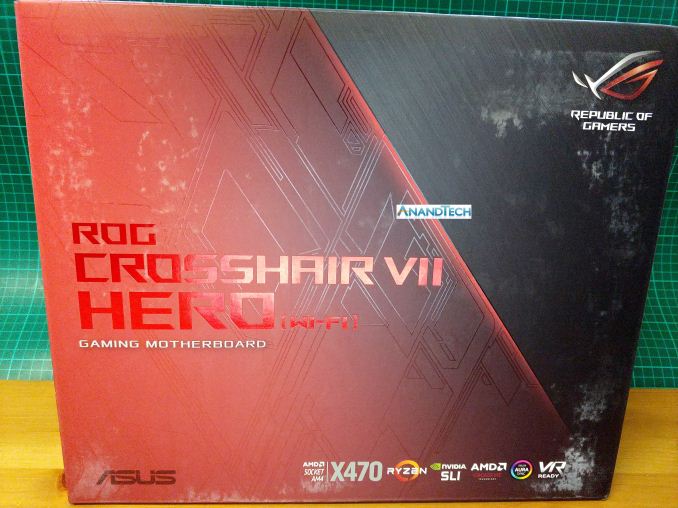

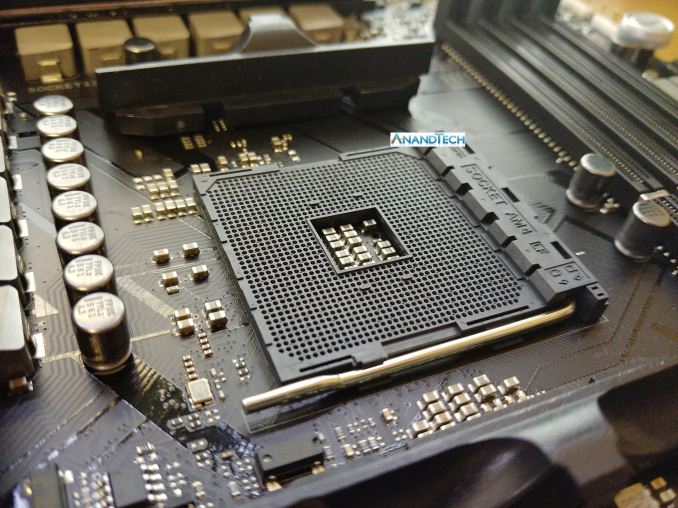
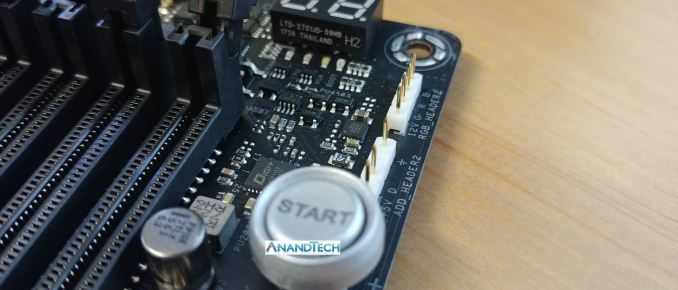

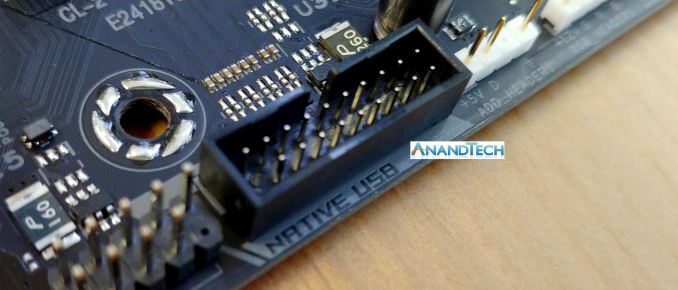
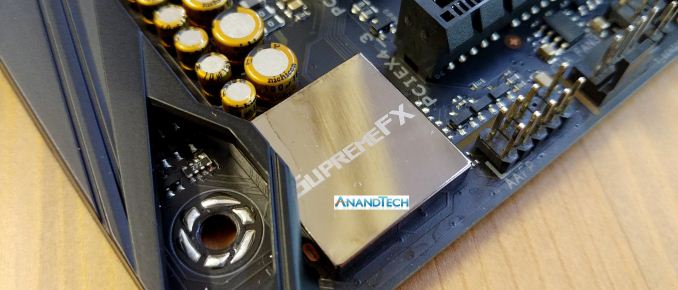
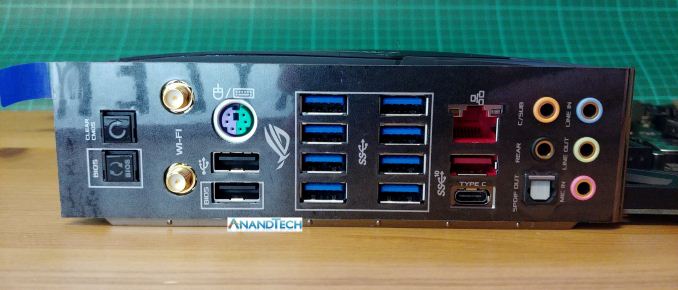






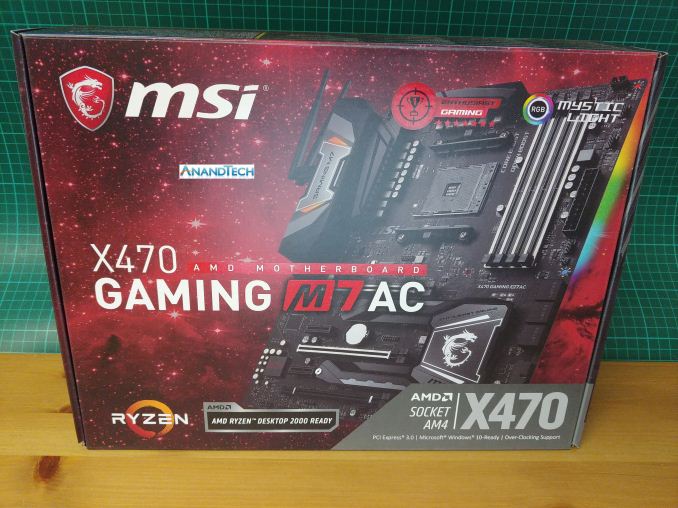
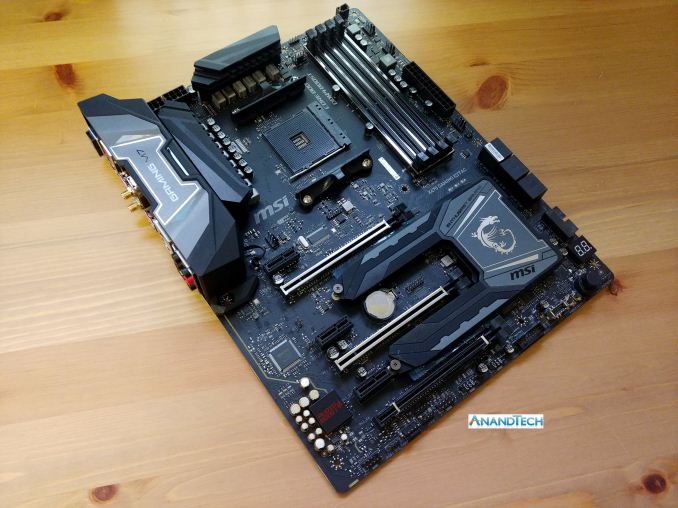
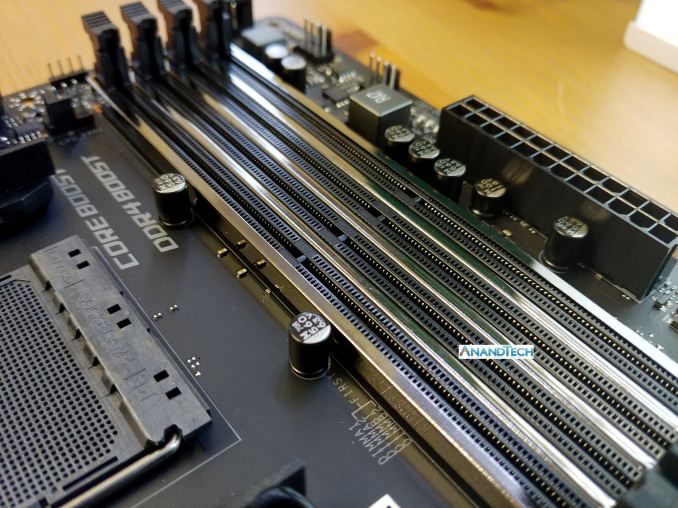
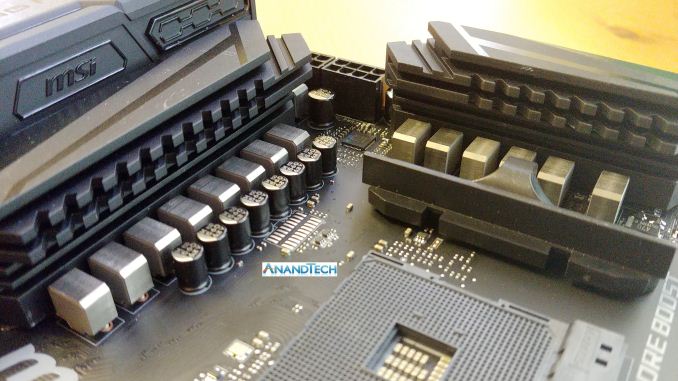

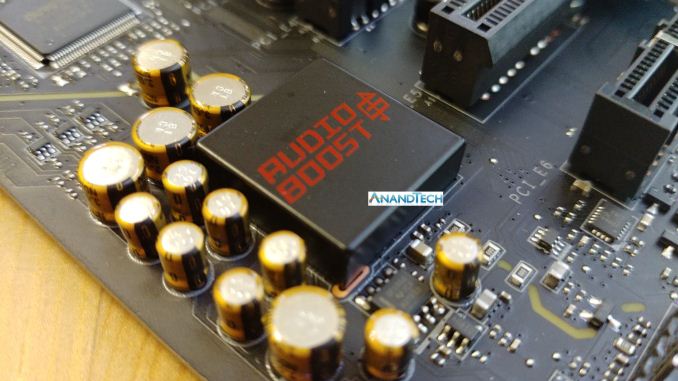
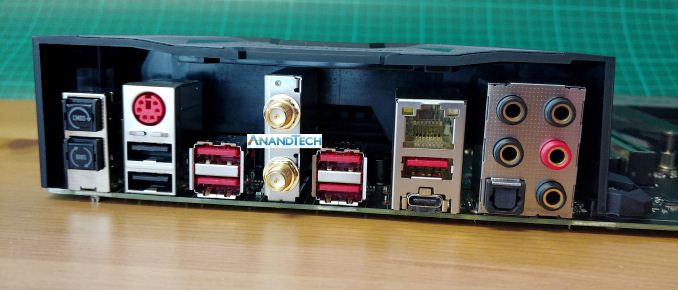
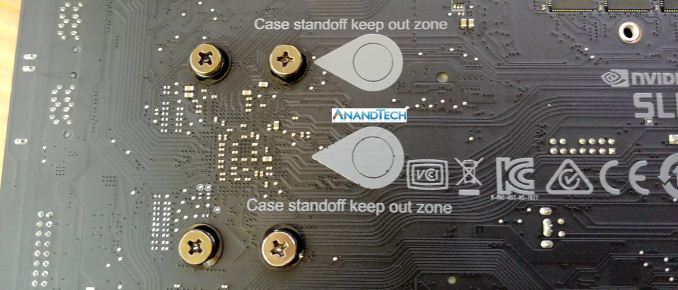
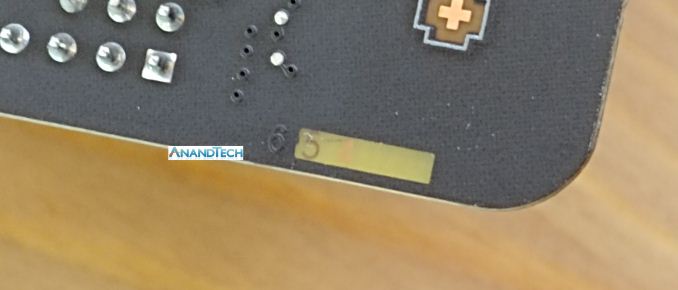














545 Comments
View All Comments
danjw - Friday, April 20, 2018 - link
They Anandtech used the rated speeds that the processors were stated to support by the manufactures. Anandtech, is using everything at stock. Anandtech ran all the processors through fully patched systems (both bios and OS). Not every website other tests to these same methodology. So, there will be differences in their results. None the less, Anandtech, is auditing their results to double check them. I really don't think they are going to see anything wrong. Toms, ran their Intel parts without the latest bios updates. Others overclocked their systems.Most users do not overclock their systems. Sure, a lot of us readers do, but not everyone. I overclock my systems, but, my two brothers who are both just as technical as I am, do not. It is a choice some make and others do not. The majority of users do not overclock. So, Anandtech does not overclock in their most reviews. They have at times in the past and may in the future include overclocking results in reviews, but they have are always broken out the overclocking results in a separate section and/or labeled the overclocked results to differentiate them from the standard clocked results. These are editorial choices that Anandtech makes, I don't see any problem with that.
Luckz - Monday, April 23, 2018 - link
Intel for some reason have 4 memory sticks. Weird idea.werpu - Friday, April 20, 2018 - link
Well the main difference is they tested against fully meltdown and specte patched systems, which in fact is the norm, while all other reviewers simply tested against bare metal. It is known that Intel took a pretty serious hit especially with Meltdown and a more serious hit with Spectre compared to AMD which did not have meltdown at all and to a lesser degree Spectre than Intel did.I would say Anandtechs tests are spot on.
And this reflects the sad state of nowadays performance testing which seems to be done to 99.9% by incompetent idiots or fanboys (especially the youtubers are the worst)
However in extreme situations Intel again wins since the 8700k can be oced by decapping and good cooling to 5GHz while the OC capabilities of the 2700x are basically non existent. It really depends, which is better. But the performance gap is closing and in non OCed system it is not existent anymore. It will be interesting next year when AMD has moved to 7nm while Intel still will be stuck at 10nm which they currently try to pull it but not have yet managed. Then the game might be entirely reversed.
Alphasoldier - Friday, April 20, 2018 - link
Unfortunatelly, you are the only idiot and fanboy here. Pretty much everyone stated in their reviews, the system were fully patched, all cpus were reused and everything was retested, because AMD fanboys were screaming Meltdown here, Spectre there.Now, the internet is full of this garbage review, it spreads like cancer, because AMD fanboys have nothing better to do, once again they are disappointed that 6 cores from Intel outperformed 8 cores from AMD and they are now like the Liverpool fans repeating "The next year will be ours"
But at least they got some fancy RBG cooler.
Fallen Kell - Friday, April 20, 2018 - link
Alphasoldier, I've been reading the reviews, and while many have stated they have applied the software (OS) patches, very few have stated they applied both the software and BIOS patches for the Spectre variant 2. Thew few places that I have seen which have stated both the software and BIOS patches were applied all seem to be showing much more similar results as the AT article.In anycase, Ryan stated they are looking into it, and I am certain we will see an update within the next few days. And don't come saying that I am a AMD fanboi, I havn't purchased a AMD CPU since the Thunderbird (i.e. a slot A CPU).
mapesdhs - Saturday, April 21, 2018 - link
werpu, oc an 8700K to 5GHz? Makes me laugh that a 300MHz bump over a CPU's max single core turbo is even called an oc these days. Sheesh, it's a far cry from the days of SB, oc hardly seems worth bothering with now.mkaibear - Thursday, April 19, 2018 - link
It's here, it's here!Dr. Swag - Thursday, April 19, 2018 - link
What is with the gaming benchmarks? On your tests the whole ryzen 2 series is a step above everything else, but all other reviews show it between ryzen and coffee lake...fallaha56 - Thursday, April 19, 2018 - link
This is the Spectre2 patch effectNot looking great for Intel and HFR gaming
Ryan Smith - Thursday, April 19, 2018 - link
"What is with the gaming benchmarks?"We're looking into it right now. Some of these results weren't in until very recently, so we're going back and doing some additional validation and logging to see if we can get to the bottom of this.